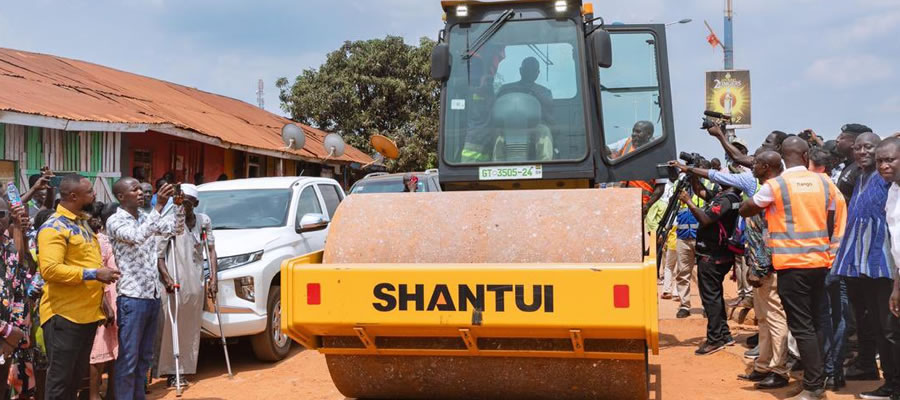

Agriculture
Agriculture is the dominant economic activity in terms of employment and income. It employs about 56.4 percent of the labor force. As the available records indicate, Agriculture is the back bone of the economy of the District.
This implies that more resources and interventions are needed to support the agriculture sector to bring about economic development of the District. This is because improvement in agriculture has the potential to increase disposable income of the people which could lead to socio-economic transformation of the District. To achieve a sustainable development, it is very imperative that the industrial sector is improved to add value to the agricultural produce.
Agriculture activities constitute the highest economic activity in the district which engages a greater majority of the total labor force. The major crops cultivated are plantain, cocoyam, cassava, vegetables, yam, maize and some exotic crops cultivated are cashew, cocoa, citrus, palm kernel, pawpaw and mango. Some of the major trees found within the district are Wawa, Odum, Sapele, Teak, and Mahogany etc.
Primary Production: Agriculture (Farming and Husbandry)
Agriculture is the main stay of the District micro economy although it is still at the rudimentary stage relying basically on hoes, cutlasses and rainfall.
Shifting cultivation, bush burning and bush fallowing are the common farming practices used by the farmers. Economic activity is therefore low with respect to output, income and employment. About 56.4 percent of the working population is estimated to be engaged in agriculture. However, small holder farmers who use traditional methods dominate these activities.
This implies that any meaningful development effort must necessarily be based on improved performance in the agriculture sector. The average farm size is as low as 2.7 acres per farmer as against the national average of 5acres. The small farm sizes affect production and consequently income and therefore the low standard of living of farmers.
Farming Systems
The common system of farming is the slash/stump and burn due to its location as a semi¬-deciduous forest zone. Two main systems of farming are adopted in the District and these are permanent cultivation (involving perennial crops such as cocoa, citrus, oil palm, sugar cane, plantain) and shifting cultivation/fallow farming (involving food crops such as maize, cassava, vegetables, plantain, cocoyam).
The food crops are either grown as a sole crop (mono crop) or mixed crops. There have been a number of technologies that are being impacted to the farmers to increase their yield and improve their living standards. These include row planting, application of poultry manure and chemical fertilizers and construction of narrow cribs for maize storage.
Source of Finance to Agriculture
Financing of agriculture in the District is mostly through personal savings. There are records of one Rural Bank and two Savings and Loans Bank which are not able to meet the financial needs of the farmers and somehow farmers are not also able to provide the needed collateral security to attract loans to facilitate their farming activities. As such, they mostly rely on the commercial banks and savings and loans financial institutions operating in the Berekum East Municipality. Self-financing constitute the main source by which farmers in the
District raises money to finance agricultural activities. This is followed by the family. The available financial institutions take the third position of sourcing the farmers in their activities. The reliance of farmers on their personal finances for their farming activities mean less money to buy inputs like agro chemicals, improved seedlings and the hiring of additional labor to expand their farm sizes and also increase yields.
Farmer-Based Co-operatives in the District
There are 7 farmer-based cooperative societies in the Berekum West District. However, the following are the societies registered by the District Directorate of Agriculture:
- Nyame Adom Gari Processing (Adom New Town)
- Awuah Farms (Cultivation of Cashew) (Abi)
- Fetentaa Cashew Farmers Association
- Amomaso Cashew Farmers Association
- Unity Farms (Cultivation of Cassava, Maize and Legumes) (Nanasuano)
- Adwenpa Farmers Association (Cultivation of Maize & Cassava) (Jinijini)
- Nkyenkyemam Maize/Cassava Farmers Association
Livestock and Poultry Farms
Livestock activities especially poultry farming in the District is mostly done on commercial basis as compared to other livestock that are done in complement to the crop farming. There are about 21 poultry farms in the district.
Date Created : 2/1/2019 4:33:29 AM











 facebook
facebook
 twitter
twitter
 Youtube
Youtube
 +233 593 831 280
+233 593 831 280 0800 430 430
0800 430 430 GPS: GE-231-4383
GPS: GE-231-4383 info@ghanadistricts.com
info@ghanadistricts.com Box GP1044, Accra, Ghana
Box GP1044, Accra, Ghana